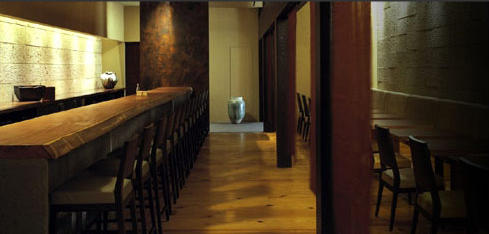Masa
 Tuesday, September 23, 2008 at 03:27PM
Tuesday, September 23, 2008 at 03:27PM 
For almost five years, I’ve been wondering…watching…waiting. Masa was there, beckoning, but I knew the expense was staggering—more than most Americans pay for rent. Last week, finally, I decided it was time.
The restaurant is named for Masa Takayama, who five years ago closed his famed Los Angeles sushi temple, Ginza Sushiko, and joined Thomas Keller to anchor the Time-Warner Center’s “Restaurant Collection.” Masa and Keller’s Per Se lived up to the hype, with eight New York Times stars and five Michelin stars between them. Other restauranteurs at the venue weren’t so lucky (Jean-Georges Vongerichten, Gray Kunz), or failed to open at all (Charlie Trotter).
The format here is a three-hour omakase—meaning you’re in the chef’s hands. The cost? It was $300 when Amanda Hesser reviewed it for the Times in 2004, had risen to $350 six months later, when Frank Bruni awarded four stars, and is now $450—assuming you don’t order the Kobe beef, which carries a $100 supplement (we took a pass). Even with a modest alcohol order, dinner for two, including the automatic 20% service charge, was $1,285, including tax.
The cost of high-end sushi is surreal. The most exclusive imported fish is expensive no matter where you have it. The omakase at Kurumazushi, which I reviewed two weeks ago, was about the same price, but a lot of the items seemed similar to one another. What is astonishing at Masa is the sheer variety. At Kurumazushi, though, we were served massive chunks of fatty tuna. Masa slices the rare fish into thin slivers.
There are just 26 seats—10 at the sushi bar (made from a single slab of hinoki wood) and 16 at the tables. We chose the bar—always a better experience at a sushi restaurant—and were fortunate enough to be at Chef Takayama’s station. There were two other sushi chefs at the counter; and behind them, two more preparing hot dishes on a grill.
When we arrived, Chef Takayama was in the midst of dismembering a hunk of toro that must have weighed thirty pounds. With a knife sharp enough to shave a mosquito, he patiently peeled apart layer after layer of flesh, separated by thin cartilage membranes. The amount of waste was considerable, though the parts not fit to be served as sushi disappeared into the kitchen, aparently to be used for some other purpose.
Masa is camera-shy, and we didn’t want to encumber our meal with note-taking. As we reconstructed the meal afterwards, we counted at least 25 items, and it may even have been a bit more than that. There were about a half-dozen appetizers, followed by wave upon wave of sushi.
The appetizers were all wonderful, but perhaps the most startling was cold sea bass with chrysanthemum—we actually ate the flower along with the fish. Another winner was a diced fish still in its own skin, with vegetables and spices: “Eat it all,” Takayama advised. The other appetizers included a crab salad, toro with caviar, truffle risotto with sea urchin, and miso soup.
A list of the sushi courses is practicaly a Who’s Who of the sea: toro, fluke, mackerel, clam, octopus, scallop, eel, shrimp, sea urchin, squid, herring—and for several of these, more than one kind. Most of the time, Takayama molds a small wedge of rice, applies a dab of wasabi, lays a slice of fish on top, paints it with soy sauce, then places it on your plate, or if it is too delicate, hands it to you directly.
Occasionally, he varies that pattern. One piece came wrapped in a cucumber skin, another in a shiso leaf. One course was a shitake mushroom; another was white truffle. A few items came from the hot station: the chef seared one piece of fish with a hot poker before serving it. Late in the meal, Takayama produced a carcass that looked like it could be a baby lamb’s rib cage. He scraped off some meat and served it to us: “Tuna bone,” he said.
Dessert was a simple bowl of grapefruit granité, which seemed like an anti-climax to the sushi theatrics.
Wine (nearly all white) is served by the bottle, sake by the carafe. Compared to the price of the food, it was pretty reasonable. Three different sakes—admittedly, some of the lower priced ones—were only $101 total, which isn’t bad when the food was $900.
The service team operates quietly and efficiently, setting and clearing so smoothly that you almost don’t realize they’re there. Serving pieces (different for each course) are practically works of art in themselves.
Masa is clearly not a populist experience. At its extravagant price, it clearly cannot be. Yet, even in these tough economic times the restaurant appeared to be doing strong business—though it was not full. We could never be regulars here, but for one night we were happy to invest in Masa’s one-of-a-kind splendor. I can’t compare it to anything in Japan, but here in New York, Masa is without peer.
Masa (Time-Warner Center, 10 Columbus Circle, 4th floor)
Cuisine: Japanese/sushi, as fancy and pricy as they come
Service: So quiet and efficient, you practically don’t realize they’re there
Ambiance: A serene oasis of calm
Rating: ★★★★






